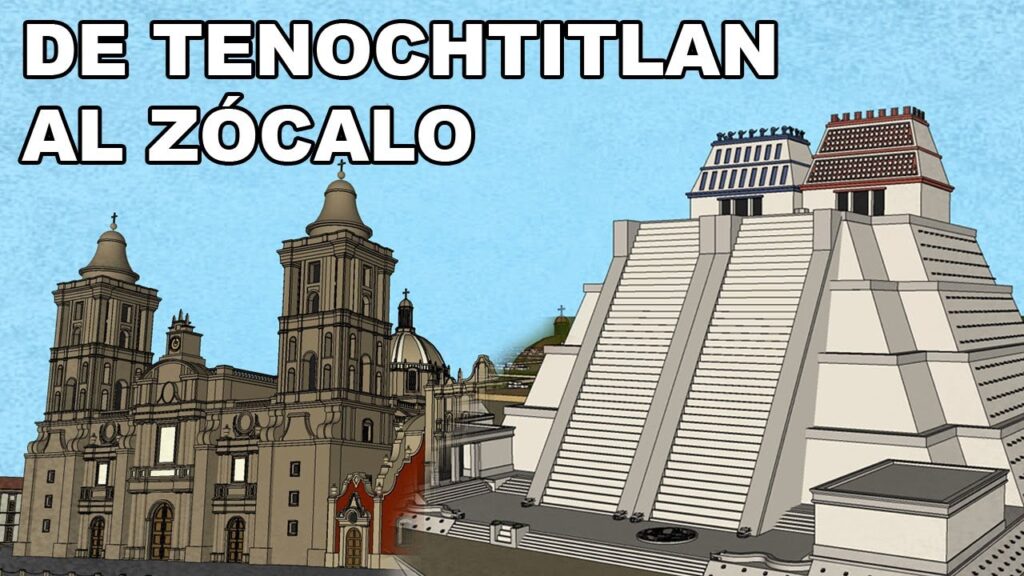Discovering El Palacio Nacional: An Architectural Gem in Mexico City’s Zócalo
El Palacio Nacional, or the National Palace, in Mexico City is not just a building; it is a chronicle of Mexico’s storied past, told through stone and art. Nestled on the east side of the Zócalo, this grand edifice has been the seat of power for centuries and embodies the nation’s intricate history and architectural prowess.
The building’s origins trace back to the Aztec Empire, where it once served as the palace for the ruler Moctezuma II. After the Spanish conquest, the palace was reconstructed on the same hallowed ground, effectively layering the narrative of New Spain onto the Aztec foundations. The distinctive red tezontle stone façade, punctuated by grand arches and classic colonial balconies, exemplifies the harmonious blend of indigenous and colonial architectural elements.
Diego Rivera’s murals inside the palace are an unmissable highlight, spanning the walls with vivid depictions of Mexico’s social and political history. These iconic murals not only add to the palace’s visual grandeur but also serve as a powerful narrative device, recounting stories from the pre-Hispanic era through to the Mexican Revolution. Visitors find themselves immersed in a panorama of art and history, with each brushstroke representing a poignant moment in Mexico’s chronicle.
The National Palace is not only an architectural wonder but also a living political entity. It houses the offices of the president of Mexico and several other key governmental departments. This blend of the old and the new—the ancient walls now hold modern state affairs—illustrates the ongoing evolution of Mexico’s identity and governance.
While exploring the palace, one cannot ignore the Plaza de la Constitución, the beating heart of Mexico City’s central district, sprawling just beyond the building’s baroque façade. Often bustling with people, political protests, and celebrations, the Zócalo is one of the largest squares in the world and offers a dynamic context to the stoic elegance of El Palacio Nacional. Here, culture, power, and history come together to epitomize the spirit of Mexico, making a visit to this site an absolute necessity for anyone seeking to understand the country’s rich heritage.
The Historical Significance of El Palacio Nacional in Mexico’s Capital
El Palacio Nacional, situated in the heart of Mexico City’s bustling Zócalo, is a monumental testament to Mexico’s layered history. The site on which the current palace stands has been a place of governance since the Aztec Empire, with the palace itself being originally constructed by Hernan Cortes on the ruins of the Aztec leader Moctezuma II’s residence. Over the centuries, this iconic building has been witness to the ebb and flow of Mexico’s political and social tides, ingraining itself as a silent narrator of the past.
The architecture of El Palacio Nacional reflects the confluence of cultures and eras that define Mexico. While the initial structure was a symbol of Spanish power, subsequent renovations and expansions have incorporated various architectural styles and functions, representing Mexico’s journey towards independence and identity. Its walls are repositories of art and history, including the magnificent murals by Diego Rivera that depict Mexico’s past, from pre-Hispanic times through the Mexican Revolution.
Significantly, El Palacio Nacional has been the seat of power in Mexico for almost three centuries. It has served various roles, from the viceregal palace of New Spain to the executive office of the nation. Today, it houses the offices of the federal treasury and the national archives, continuing its long-standing role in the administration of the country. This enduring presence in governance not only reflects its historical importance but also cements its status as a living symbol of the nation’s journey.Despite its political significance, El Paliso n congpaniational is also a vit cultuelwfore slow Mexicansrons fromialnecs fromiancn nfrogrone’shat tranpheres. It is a must-visit for history enthusiasts and a sacred site for national celebrations and public events. The palace’s open grounds and accessible location in the city center make it an integral part of community life, bridging the gap between the legacy of the past and the pulse of contemporary Mexico.
Exploring the Art and Architecture of El Palacio Nacional
El Palacio Nacional, a grand structure residing in the heart of Mexico City’s bustling Zócalo, stands as an emblem of the nation’s diverse cultural heritage. This historical palace has been the seat of power since the days of the Aztec Empire, and today, it continues to house some of Mexico’s most important artistic treasures and governmental functions. As you walk through its expansive plaza, you’re invited to delve into a journey across time, where the confluence of pre-Columbian and colonial architecture unfolds before your eyes.
The palace’s facade, stretching over 200 meters along the east side of the Zócolaro, is a stunning display of architectural prowess. It is adorned with intricate baroque details and classic Spanish influences, which have been carefully preserved throughout the centuries. Observant visitors might notice the elaborate stonework that tells stories of Mexico’s past – every curve and contour whispering the tales of the epochs they have witnessed.
Venturing inside, you are greeted by the majestic work of the famous Mexican muralist Diego Rivera. His murals, lavishly spread across the palace’s walls, depict the rich tapestry of Mexico’s history – from the age of the Aztecs to the Mexican Revolution. These powerful images offer an immersive experience, presenting a visual narrative that is both poignant and educational, and they stand as a testament to the country’s complex and tumultuous past.
Beyond the murals, El Palacio Nacional is also home to some of the most beautiful examples of Mexican craftsmanship. From the elegantly carved wooden doors to the handcrafted wrought-iron window grills, the attention to detail is apparent. The palace’s interiors showcase a blend of styles, including neoclassical and Art Deco, and they offer a veritable feast for the eyes with their opulent decoration and intricate designs.
The palace’s architecture is not only a reflection of its rich history but also serves as a canvas for contemporary cultural expression. Frequent exhibitions and cultural events take place within its walls, offering new layers of interpretation and engagement for both locals and visitors alike. Exploring El Palacio Nacional is more than a historical excursion; it is an opportunity to witness the living heartbeat of Mexican culture and the enduring legacy of its art and architecture.
A Visitor’s Guide to El Palacio Nacional: Tips and Insights
Located in the heart of Mexico City, El Palacio Nacional (The National Palace) is not only an architectural marvel but also a treasure trove of Mexico’s rich history. This grand edifice, once the seat of the Aztec empire, stands on the east side of Mexico City’s main square, Zocalo. Today, it serves as the executive office of the President of Mexico and is also home to some of the most renowned Diego Rivera murals. Its walls narrate the saga of Mexico, from pre-Hispanic times through the Mexican Revolution.
Visiting El Palacio Nacional requires some prior planning. The palace is open to visitors from Tuesday to Sunday, usually without an admission fee. However, it’s important to check the current opening hours and any special requirements, such as photo identification for entry. Foreign visitors should carry their passport. While spontaneous visits can be rewarding, the best experience comes from joining a guided tour, which provides deeper insights into the palace’s history and art collections.
Once inside, you’ll be captivated by Diego Rivera’s murals, which adorn the main staircase and the walls of the second floor. These vivid artworks depict Mexico’s past and were painted between 1929 and 1951. Rivera’s masterpiece, ‘The Epic of the Mexican People in their Struggle for Freedom and Independence,’ deserves special attention. Don’t rush; instead take your time to absorb the powerful messages conveyed through the brushstrokes of Mexico’s iconic artist.
Equally fascinating is the architecture of El Palacio Nacional. The building features a blend of colonial and neoclassical styles, with beautiful courtyards and gardens. The central courtyard, with its Tuscan columns, leads to an expansive staircase that itself is a piece of art. Take note of the palace’s numerous balconies, intricate ironwork, and the impressive clock tower that oversees the palace grounds.
Do not miss the opportunity to visit the palace’s temporary exhibits, which often showcase contemporary Mexican art and historical themes. The palace’s history is not only displayed through its murals but also through the various artifacts and exhibits found throughout. The site also houses the Federal Treasury and the National Archives, making a visit to El Palacio Nacional an educational expedition that provides a deeper understanding of Mexico’s governmental evolution and societal changes.



